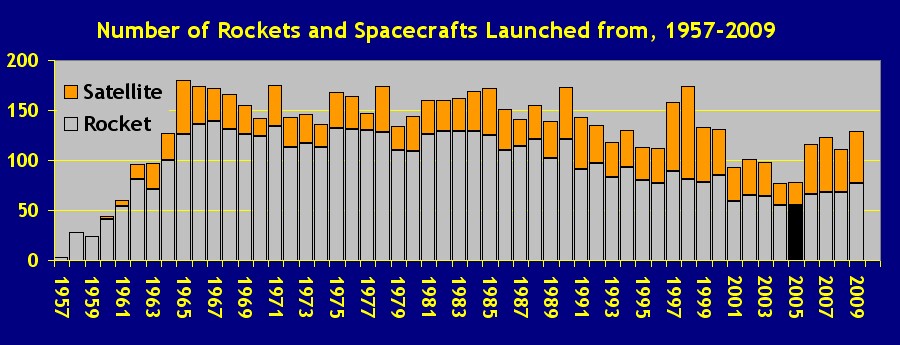A Not-so-busy Year
In 2005, 78 spacecrafts were
launched. This represents the third year in row during which less than
100 spacecrafts were launched. From 1964 to 2000, an average of 155 spacecrafts
were launched every year, but there were only 93
spacecrafts launched in 2001, 101
in 2002, 98 in 2003 and 77
in 2004. (See Table 1 - Numbers
of Spacecrafts Launched Each Year.)
A Russian Domination?
The year 2005 was marked by three facts:
1°) Russia alone sponsored a quarter
of all spacecrafts launched,
2°) 56 % of all spacecrafts
were launched by Russia, and
3°) Russia accomplished 55
% of all rocket launches.
Who Sponsored What?
Of the 78 spacecrafts launched
this year, 21 were Russian, 13
American, 15 European, 10
commercial, 6 Chinese, 5
Japanese, 3 Indian, 1
Canadian, 1 Thai, 1
Iranian, 1 Indonesian and 1
amateur.
Civilian vs. Military Spacecrafts
62
of the 78 spacecrafts launched
during 2005 were civilian which represents 79.5 % of the total and
16
were military satellites. From 1960 to 1990, two-third of all spacecrafts
launched were military, but since 1995, the majority are civilian. Nevertheless,
56.3 % of all spacecrafts ever launched are military. (See
Table
4.)
For What Purpose?
Of the
62 civilian spacecrafts, 21
provided communications services, 15
were for technology R&D, 8 were
part of piloted programs, 4 studied
Earth and space environment, 4
explored the Solar System and 3 observed
Earth weather patterns.
Of the
16 military satellites, 5
were for reconnaissance (spy) mission, 5
provided navigation aids, 2 were listening
devices (elint), 2 relayed communications
and 2 were for science &
technology research.
Space Failures
8
of the 78 spacecrafts failed
to accomplish their mission. This represents a 89.7 % rate of success.
This is a little bit better than the historical average (1957-2004 = 89.1
%), but is about 2 % less than the rate observed in recent years.
Of these 8 failures, 3 occurred at launch and 5 spacecrafts failed to complete
their mission. (See Table 6 and Spacecrafts
(know) Failure.)
Launcher Statistics
The 78 spacecrafts launched during
2005 were carried by 55 rockets. 30
of these rockets were Russian (55 %), 12 were American,
5
were European, 5 were Chinese, 2 were
Japanese and 1 was Indian. (See Spacecrafts/Launches
Summary below.)
Come Fly With Us
Russian rockets launched 44 of the 78
spacecrafts (56 %), American rockets carried 14 spacecrafts,
European Ariane orbited 10 spacecrafts, Chinese Chang
Zheng propelled 6 spacecrafts, and Japanese & Indian
launchers transported 2 spacecrafts each.
Payloads Tonnage:
|
| Launch Provider |
Number of Payloads |
Total Weight Launched |
% of
Total |
| Russia |
44 |
109,995+kg |
32,6 % |
| United States |
14 |
168,986 kg |
50,1 % |
| Europe |
10 |
32,658 kg |
9,7 % |
| Japan |
2 |
4,980 kg |
1,5 % |
| China |
6 |
18,941 kg |
5,6 % |
| India |
2 |
1,603 kg |
0,5 % |
| Total |
|
339,736+Kg |
|
| Lost Payloads |
3 |
2,537 kg |
|
|
Launch Failures
There were 3 launch failures: a Molniya rocket carrying a Molniya
comsat, a Vonla carrying The Planetary Societys Cosmos-1,
and a Rokot carrying Cryosat.
This represents a 94.5 % rate of success, which is better than the average
91.5 % success cumulated from 1957 to 2004. (See Table
11 - Launchers Ranking.)
Launcher Scorecard
Of the 55 launches accomplished during the year 2005:
| |
The Russian Soyuz
(Molniya) launcher score 11 successes in 12 launches. |
| |
The Russian Proton
launcher score 7 successes in 7 launches. |
| |
The European Ariane
and the Chinese Chang Zheng both score
5 successes in 5 launches. |
| |
The Russian
Zenit
score 4 successes in 4 launches. |
| |
American Atlas &
Delta
and the Russian
Kosmos 3M each score 3 successes
in 3 launches. |
| |
American Titan and
Minotaur
score 2 successes in 2 launches. |
| |
American Space Shuttle
and
Pegagus, Japanese H-2A
and M-V, the Russian Dnepr
and the Indian PSLV each score 1 success
in 1 launch. |
| |
The Russian Rokot
score 1 success in 2 launches. |
| |
The Russian Volna score 1 failure in 1 launch. |
.
Spacecrafts / Launches Summary
.
Russian Launches
|
Launcher |
|
Payloads |
| 12 |
Soyuz: |
|
Progress
M-52,
TNS-0
Nanosputnik |
|
|
|
Soyuz
TMA-6 |
|
|
|
Foton
M-2 |
|
|
|
Progress
M-53 |
|
|
|
(Molniya
3) |
|
|
|
Galaxy
14 |
|
|
|
Kosmos
2415 |
|
|
|
Progress
M-54 |
|
|
|
Soyuz
TMA-7 |
|
|
|
Venus
Express |
|
|
|
Progress
M-55 |
|
|
|
Giove
A |
| 7 |
Proton: |
|
AMC-12 |
|
|
|
Ekspress
AM-2 |
|
|
|
DirecTV
8 |
|
|
|
Ekspress
AM-3 |
|
|
|
Anik
F1R |
|
|
|
Kosmos
2417
Kosmos
2418,
Kosmos
2419 |
|
|
|
AMC-23 |
| 4 |
Zenit: |
|
XM Radio
3 |
|
|
|
Spaceway
1 |
|
|
|
Intelsat
Americas 8 |
|
|
|
Inmarsat
4F-2 |
| 3 |
Kosmos 3M: |
|
Kosmos
2414
Universitetskiy |
|
|
|
Beijing-1,
TopSat,
SSETI-Express,
Sihah
1,
UWE
1,
CubeSat
XI-V,
NCube-2,
Mozhayets
5,
Rubin
5 |
|
|
|
Gonets
D1M1,
Kosmos
2416 |
| 2 |
Rokog: |
|
Monitor-E |
|
|
|
(Cryosat) |
| 1 |
Dnepr: |
|
Kirari,
Reimei |
| 1 |
Volna: |
|
(Cosmos-1) |
|
American Launches
European Launches
Chinese Launches
Japanese Launches
Indian Launches
|
2005 Payloads Weights Orbited
|
Russian-launched
|
American-launched
|
European-launched
|
Japanese-launched
|
| Payloads |
W. (kg) |
| Kosmos
2414 |
820 |
| Universitetskiy |
30 |
| AMC-12 |
5,000 |
| Progress
M-52 |
7,250 |
| XM Radio
3 |
4,703 |
| TNS-0 |
5 |
| Ekspress
AM-2 |
2,600 |
| Soyuz
TMA-6 |
7,250 |
| Spaceway
1 |
6,080 |
| DirecTV
8 |
3,711 |
| Foton
M-2 |
6,535 |
| Progress
M-53 |
7,250 |
| Molniya
3 |
(1,750) |
| Cosmos-1 |
(103) |
| Intelsat
IA-8 |
5,500 |
| Ekspress
AM-3 |
2,600 |
| Galaxy
14 |
2,087 |
| OICETS |
570 |
| INDEX |
60 |
| Monitor-E |
700 |
| Kosmos
2415 |
6,600 |
| Progress
M-54 |
7,250 |
| Anik
F1R |
4,500 |
| Soyuz
TMA-7 |
7,250 |
| Cryosat |
(717) |
| Beijing-1 |
166 |
| TopSat |
|
| SSETI-Express |
62 |
| Sihah
1 |
160 |
| UWE
1 |
|
| CubeSat
XI-V |
|
| NCube-2 |
|
| Mozhayets
5 |
|
| Rubin
5 |
|
| Inmarsat
4F-2 |
6,000 |
| Venus
Express |
1,300 |
| Progress
M-55 |
7,250 |
| Gonets
D1M1 |
225 |
| Kosmos
2416 |
225 |
| Kosmos
2417 |
225 |
| Kosmos
2418 |
225 |
| Kosmos
2419 |
225 |
| Giove
A |
600 |
| AMC-23 |
4,981 |
| Total Orbited: |
109,995 |
|
| Payloads |
W. (kg) |
| DI
"flyby" |
601 |
| DI
"impactor" |
372 |
| NROL-23 |
4,000 est |
| NROL-23 |
4,000 est |
| Inmarsat
4-F1 |
5,959 |
| XSS-11 |
145 |
| DART |
360 |
| USA
182 |
14,500 |
| NOAA
18 |
1,420 |
| STS-114 |
85,000 est |
| MRO |
2,180 |
| STP-R1 |
417 |
| Navstar
57 |
2,032 |
| Improved
CRYSTAL |
18,000 |
| Total Orbited: |
138,.986 |
|
| Payloads |
W. (kg) |
| XTAR-EUR |
3,631 |
| Maqsat-B2 |
3,622 |
| Sloshsat-FLEVO |
127 |
| Thaicom
4 |
6,486 |
| Syracuse
3A |
3,725 |
| Galaxy
15 |
2,033 |
| Spaceway
2 |
6,000 |
| Telkom
2 |
1,900 |
| Insat
4A |
3,200 |
| MSG-2 |
2,034 |
| Total Orbited: |
32,658 |
|
|
Total Mass does notcounted paylods that
faild to orbit) |

